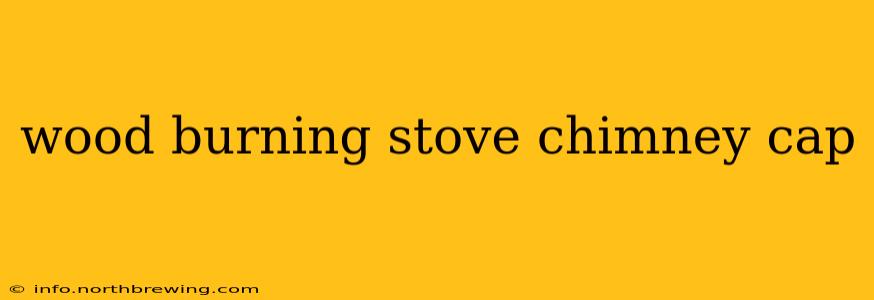A wood burning stove chimney cap is a crucial component of any wood-burning system. It safeguards your home and the efficiency of your stove by preventing rain, snow, and debris from entering the chimney, while also improving the draft. This comprehensive guide will explore everything you need to know about choosing, installing, and maintaining a chimney cap for your wood burning stove.
What are the Benefits of a Chimney Cap?
A chimney cap offers a multitude of benefits, extending the lifespan of your chimney and enhancing your overall heating experience. These include:
-
Protection from the elements: This is the primary function. A cap prevents rain, snow, and ice from entering your chimney, preventing water damage to the flue lining and the potential for dangerous chimney fires caused by accumulated moisture. It also keeps out leaves, twigs, and other debris that can restrict airflow and create a fire hazard.
-
Improved draft: A well-designed chimney cap can actually improve the draft in your chimney, ensuring efficient combustion and reducing creosote buildup. This leads to better heat output and reduced fuel consumption.
-
Animal Deterrent: Birds, squirrels, and other animals can nest in your chimney, creating blockages and potential fire risks. A cap effectively seals the top of your chimney, preventing this.
What Types of Chimney Caps Are Available?
Several types of chimney caps cater to different chimney sizes and architectural styles. Choosing the right one is essential for optimal performance and aesthetic appeal. The most common types include:
-
Standard Chimney Caps: These are the most basic and widely available. They typically feature a simple, flat design with a mesh screen to keep out debris.
-
Adjustable Chimney Caps: These offer flexibility for chimneys with varying diameters, providing a more customized fit.
-
Decorative Chimney Caps: For those who prioritize aesthetics, decorative caps come in various styles and finishes, such as copper, stainless steel, or even cast iron, enhancing the visual appeal of your home's exterior.
How Do I Choose the Right Chimney Cap for My Wood Burning Stove?
Selecting the appropriate chimney cap requires careful consideration of several factors:
-
Chimney Size: Measure the diameter of your chimney opening accurately to ensure a proper fit. Too small, and it won't cover properly; too large, and it won't secure correctly.
-
Material: Stainless steel is the most popular choice for its durability and resistance to corrosion. Copper and other metals are also available but might require more maintenance.
-
Style: While functionality is paramount, consider the architectural style of your home when choosing a design. A decorative cap can complement your home's exterior beautifully.
How Do I Install a Chimney Cap?
Installing a chimney cap can be done by a professional or a competent DIYer. It typically involves:
-
Measuring and securing: Ensure the cap fits snugly and is securely attached to the chimney using appropriate fasteners.
-
Weatherproofing (if necessary): Some caps may require additional sealant or weatherproofing around the edges to prevent water ingress.
-
Safety Precautions: Always work safely, using appropriate safety gear when working at height.
How Often Should I Inspect My Chimney Cap?
Regular inspection is essential to maintain the integrity of your chimney cap and the overall efficiency of your wood-burning system. At least once a year, check for:
-
Damage or corrosion: Look for signs of rust, damage, or loose fasteners.
-
Blockages: Check for any debris build-up that might be restricting airflow.
-
Proper sealing: Ensure the cap is securely attached and effectively sealed to prevent water infiltration.
What Happens if I Don't Use a Chimney Cap?
Operating a wood-burning stove without a chimney cap significantly increases the risk of:
-
Water damage: Rain and snow can damage the chimney flue, leading to costly repairs or even chimney collapse.
-
Chimney fires: Accumulated debris and moisture inside the chimney can create a fire hazard.
-
Pest infestation: Animals can nest inside the chimney, causing blockages and structural damage.
Can I install a chimney cap myself?
Yes, many homeowners can install a chimney cap themselves, but it's crucial to assess your comfort level with heights and working on the roof. If you're uncomfortable, hiring a professional chimney sweep is always the safer option. Improper installation can lead to safety hazards.
What are some common problems with chimney caps?
Common issues include improper fit leading to leaks, rust or corrosion due to poor-quality materials, and blockages from debris if the mesh is too fine or clogged. Regular maintenance can prevent most of these issues.
How much does a chimney cap cost?
The cost varies greatly depending on the material, size, and style of the cap. Expect to pay anywhere from a few tens of dollars for a basic model to several hundred dollars for a more elaborate or custom-designed cap.
By following the guidance provided in this article, you can ensure your wood-burning stove operates efficiently and safely for years to come. Remember that safety should always be your top priority when dealing with your chimney and wood-burning appliance.
